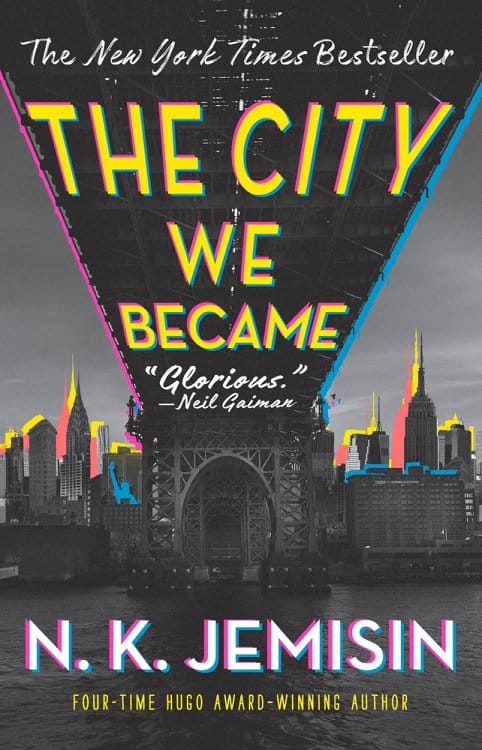The City We Became: A Vivid Urban Fantasy Review
Explore themes, characters, and social commentary in N. K. Jemisin’s urban fantasy "The City We Became" and discover why the novel is a must-read.

Introduction
Few books capture the pulse of New York City as palpably as N. K. Jemisin’s "The City We Became." Part cosmic horror, part superhero origin story, and wholly urban fantasy, the 2020 novel anthropomorphizes the five boroughs into living avatars who must defend their home against an ancient, other-dimensional enemy. In roughly four hundred pages, Jemisin interrogates colonialism, racism, and gentrification while delivering break-neck action and razor-sharp dialogue. The result is a story that feels both mythic and unmistakably contemporary.
A Quick Synopsis
The premise is deceptively simple: when a city reaches a certain critical mass of culture and consciousness, it becomes alive. New York’s birth should be triumphant, yet something goes awry. The primary avatar—an unnamed young Afro-Latino man—falls into a coma during the city’s emergence, leaving the five borough avatars of Manhattan, Brooklyn, the Bronx, Queens, and Staten Island scrambling to defend the metropolis. Pursued by the eldritch Woman in White, the avatars must unite before the Enemy subsumes their city entirely.
Why the City Needs Avatars
Jemisin’s concept of urban avatars serves multiple narrative purposes. First, it offers a clever mechanism to embody local identity; second, it provides immediate stakes. If the boroughs cannot synchronize and awaken the primary avatar, New York—home to more than eight million people—will die. By turning geography into character, Jemisin lets reader loyalty to their favorite neighborhoods double as emotional investment in the protagonists’ survival.
Characters as Boroughs
Each avatar reflects the history and personality of their borough. Manhattan’s avatar, Manny, is ambitious, sharp, and financially savvy, yet struggles with amnesia—mirroring the borough’s ceaseless reinvention. Brooklyn, a former rapper turned city councilwoman, embodies resilience, rhythm, and political clout. Bronca, the Bronx avatar, is a Lenape lesbian art curator whose guarded toughness hides deep community roots. Queens finds representation in Padmini, a Tamil American graduate student whose mathematical brilliance channels the immigrant dream. Isolated Staten Island avatar Aislyn is torn between familial loyalty and fear of change, reflecting the borough’s red-leaning sensibilities.
Themes: Identity, Gentrification, Resistance
"The City We Became" is more than urban spectacle; it is a trenchant commentary on systemic oppression. The Woman in White’s invasive tendrils disguise themselves as bland billboards, luxury developments, and racist microaggressions, literalizing the slow violence of gentrification. Jemisin insists that resistance is collective and intersectional: characters win only when they listen to one another’s lived experiences. The novel argues that the soul of a city lies in its marginalized communities, not in sanitized corporate facades.
Jemisin’s Writing Style
Fans of the author’s Hugo-winning Broken Earth trilogy will recognize her fearless experimentation. Jemisin wields second-person narration, page-long rants, and comedic asides with equal flair. Slang, academic jargon, hip-hop lyrics, and eldritch chants collide in prose that feels as polyglot as the subway at rush hour. The pacing rarely lags; set-piece battles erupt in Harlem streets or atop the Staten Island Ferry, yet quieter moments—Bronca preserving Indigenous artifacts, or Manny mourning forgotten memories—add emotional heft.
New York City as a Character
Literary depictions of New York abound, but Jemisin’s version stands apart because the city literally speaks. Graffiti sputters warnings, traffic lights wink conspiratorially, and subway tunnels echo with primordial heartbeats. By personifying infrastructure, the author highlights how communities imprint their personalities on shared spaces. The city’s cacophony becomes an orchestra: salsa rhythms in the Bronx, bhangra beats in Queens, trap drums in Brooklyn—all harmonizing against the dissonant screech of colonizing forces.
Cultural Commentary You Can Feel
Underneath the fantasy trappings is a call to vigilance. The book was released during global protests for racial justice, and its scenes of police harassment, ICE raids, and viral misinformation feel ripped from headlines. Yet the tone is defiantly hopeful. The avatars find power in mutual aid networks, queer clubs, and community board meetings—real-world institutions readers can support. By framing activism as urban magic, Jemisin invites audiences to imagine civic engagement as something thrilling rather than tedious.
Impact on Urban Fantasy
"The City We Became" expands the boundaries of its genre. Urban fantasy often centers individual chosen ones; Jemisin decentralizes heroism, insisting on a chorus of voices. Her fusion of Lovecraftian horror with hip-hop culture challenges the field’s Eurocentric defaults. Moreover, the novel treats setting not merely as backdrop but as organism, encouraging future authors to experiment with similar narrative architectures. It is no surprise that the book earned nominations for the Hugo, Nebula, and Locus awards within months of publication.
Final Thoughts
At roughly 800 pages in imagination if not in actual length, "The City We Became" is ambitious, messy, and exhilarating—much like New York itself. Whether you’re a lifelong resident, a recent transplant, or a distant admirer, the novel urges you to consider what makes a city more than steel and stone. It argues that place is people, and that people deserve to write their own stories. For readers craving speculative fiction that punches up while dancing in the streets, this book is a must-read.



